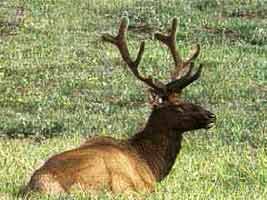Animal Arsenal

Animals' lives are not peaceful! They must be able to find food for themselves and their young (which often includes tracking and killing it), and avoid becoming food themselves. Sometimes they must also compete with others of their own kind—for food, territory, or mates. Here are some of the innovative means animals have developed for attack and defense:
Antlers: The deer family, including elk, moose, and caribou, use their antlers to defend themselves from predators and duel for mates.
 IMSI Master Clips |
Camouflage: Coloring that matches or blends with an animal's surroundings helps the animal to hide. The Arctic fox, green tree frog, penguin, and polar bear are a few of the animals who use this method in defense. Some animals, like the chameleon and octopus, can actually change the color of their skin to match their surroundings!
 IMSI Master Clips |
Claws: Bears, owls, and tigers are some of the animals who use their sharp claws to fight as well as to catch prey.
Ejection: Both cuttlefish and squid eject black inky fluid that helps them hide from predators. The sea cucumber squirts its insides out to defend itself! (It then grows a new stomach.)
Explosions: Self-sacrificing ants explode in the face of the enemy to save their colony. A South American lizard squirts blood from its eyes to repel enemies.
Feet: A large bird, like the ostrich, has a powerful kick. Elephants, cottontail rabbits, and kangaroos also use their feet to fight.
Horns: Goats, sheep, and water buffalo use their horns to fight in the same way that deer use their antlers.
Odor: Skunks aren't the only animals to use scent glands for defense. Some others are bedbugs, cockroaches, earwigs, foxes, mink, snakes, weasels, and wolverines.
Poison: Many animals have poison glands, such as toads, moths, snakes, and spiders. Coral snakes and cottonmouth snakes are poisonous. The platypus has poison in its spurs. The spines of some fish like the stone fish and scorpion fish are poisonous.
Shocks: The electric catfish, electric eel, and electric ray all use electric shock to paralyze or damage their victims.
Spitting: The archer fish spits water from a “blowgun” in the roof of its mouth to capture the bugs it eats. The jawfish spits pebbles from its mouth to defend itself. The spitting cobra spits its venom (poison) into the eyes of its enemy.
Stings: A sting pierces, hurts, and sometimes poisons the victim. A few of the many stinging animals are the bee, jellyfish, Portuguese man-of-war, sea urchin, and wasp.
Tails: Lizards use their tails to hit their enemies or knock them over.
Teeth: Baboons, mice, squirrels, rats, wolves, and woodchucks use their teeth as both defensive and offensive weapons.
Tongues: Anteaters, chameleons, frogs, and lizards use their tongues to catch prey.
Tusks: The African wart hog and the walrus use their tusks to fight enemies.
